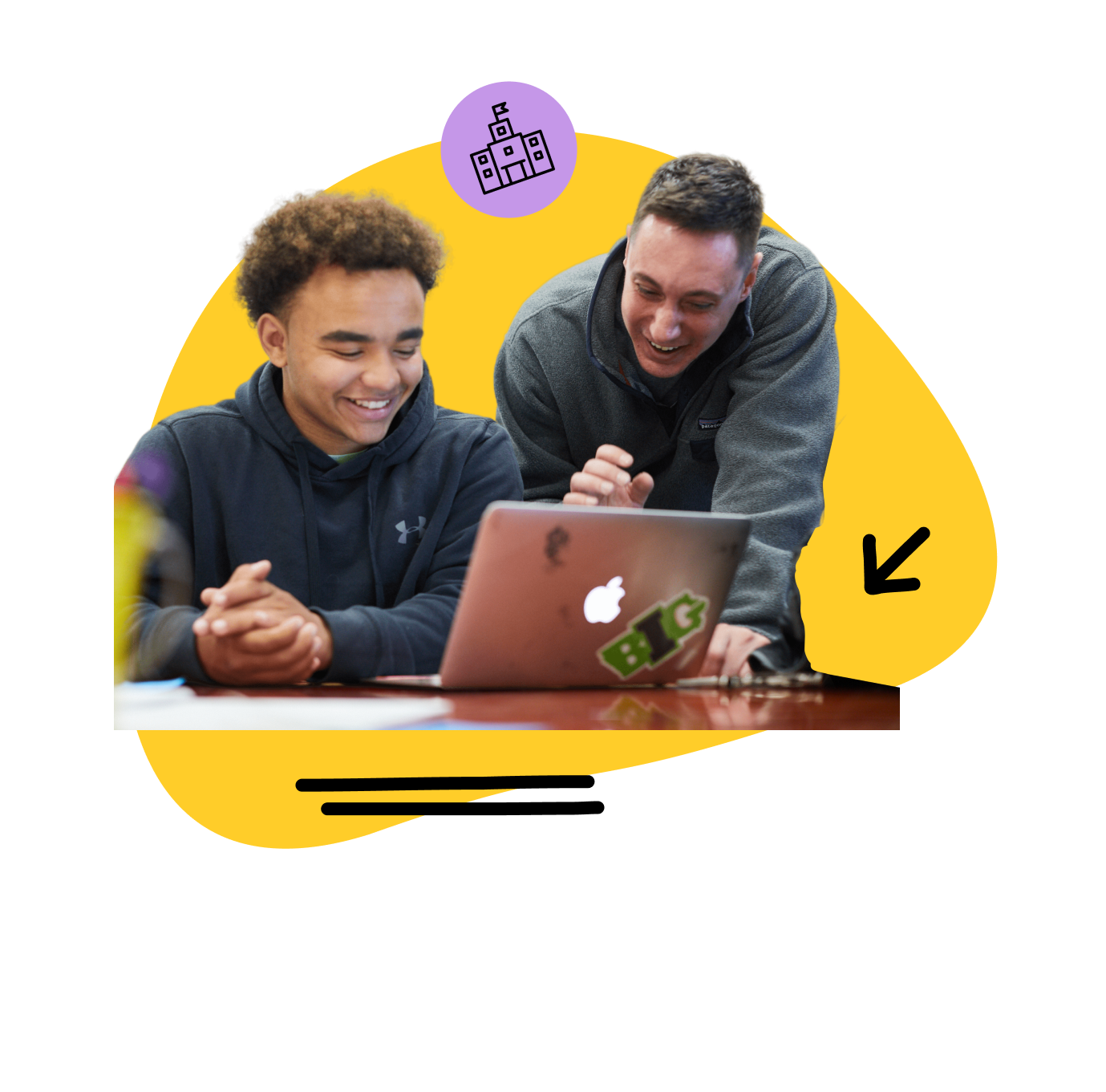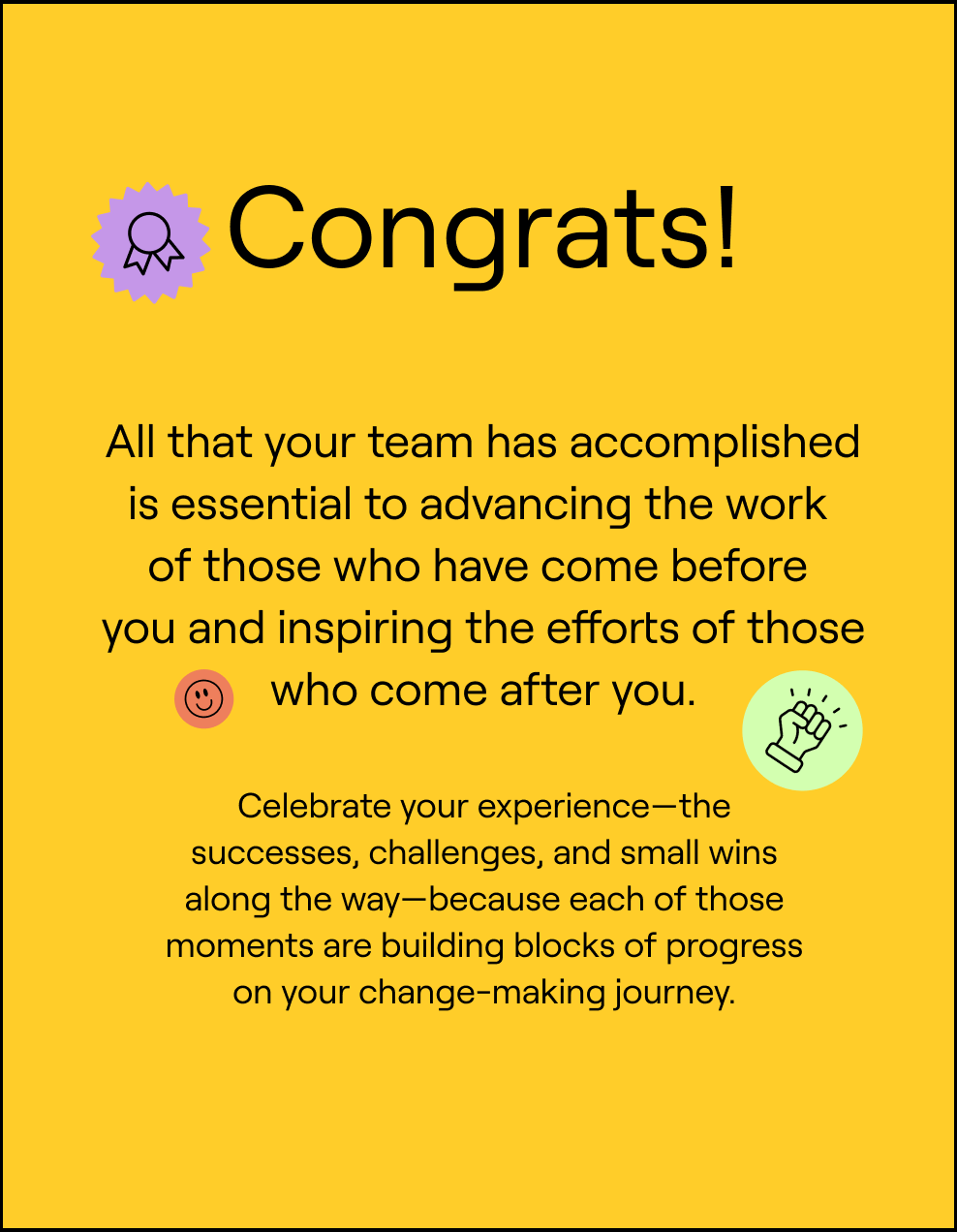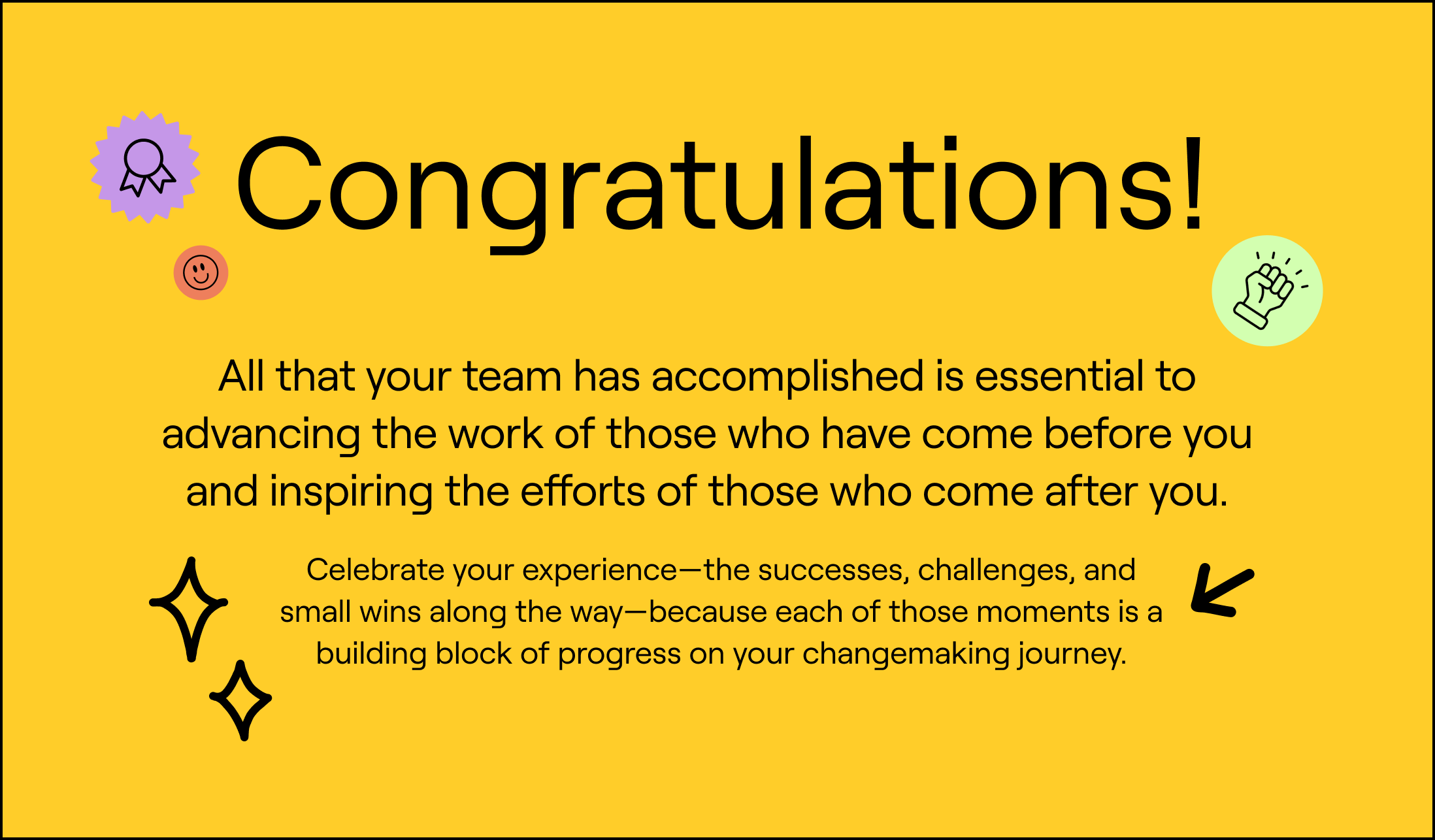
Act
How to achieve
your change
Elizabethton students created the Student Committee of Volunteers–a committee driven by students who volunteer their time and effort to see school-wide improvements come to life.

Trust in the preparation that has been done, because now is the time for action! Jump to the final piece of this toolkit, and use these five steps to help usher in the specific change being pursued.


Taking
action—and enacting
change—is
an art form!

Key Concept
It pays to be thoughtful about how, when, and why teams and communities work together to advance an effort and capitalize on momentum. How can your team keep the change effort going and drive it forward?



wins, and moments of
togetherness
progress both individually
and as a team
Generate buzz around the
work being done through
share-outs and updates



the change area
often, making changes when
necessary
Celebrate accomplishments,
wins, and moments of
togetherness

Learn more together
about
the change area

Measure and reflect on
progress both individually
and as a team

Communicate and capture
the journey by journaling,
posting on social media, and
sharing with the broader
community

Generate buzz around the
work being done through
shareouts and updates

Revisit the plan and timeline
often, making changes when
necessary

![]() Tip:
Tip:
Kickoffs are one of many ways to build momentum to advance an effort. In change-making, finding momentum is an engaging and encouraging way for your team and the people around you, to take action, and build support to achieve your vision.


Team Exercise
Plan a kickoff
Teams that nurture one another and their change think about what it takes to kick off their changemaking in an exciting, provacative, and celebratory way.
Objectives:
![]() Determine where and when the
Determine where and when the
kickoff will take place, and the
agenda
![]() Align on how the event will be
Align on how the event will be
promoted and who will be invited
![]() Discuss speaking roles and what
Discuss speaking roles and what
success will look like

![]() Tip:
Tip:
Kickoffs are one of many ways to build momentum to advance an effort. In change- making, finding momentum is an engaging and encouraging way for your team, and the people around you, to take action and build support to achieve your vision.
Stories
are a
critical part of how
to make change.



Stories
are a
critical part
of how to
make change.




Key Concept
When students share their stories, they change not only their high school but also the world. Look to use the art of storytelling to build a community of supporters and start with a story of Self, Us, and Now
 Self
Self
Revisit exercise 1: Understand yourself.
Why are we called to this change and the work of changemaking?
How were you changed by this process?
 Us
Us
Revisit exercise 4: Define the change.
What values, experiences, and aspirations of our high school community drive this work?
What makes this goal commonly shared?
 Now
Now
Revisit exercise 7: Craft the vision.
What makes this opportunity and change urgent?
What is unique today that drives action?
 Self
Self
Revisit exercise 1: Understand yourself.
Why are we called to this change and the work of changemaking?
How were you changed by this process?
 Us
Us
Revisit exercise 4: Define the change.
What values, experiences, and aspirations of our high school community drive this work?
What makes this goal commonly shared?
 Now
Now
Revisit exercise 7: Craft the vision.
What makes this opportunity and change urgent?
What is unique today that drives action?
* Adapted from Marshall Ganz.
2009. What Is Public Narrative:
Self, Us & Now

Team Exercise
Tell the story
The team is likely already telling a motivating story of change through social media posts, texts, and posters to the community. Now’s the time to bring it all together and tell the vibrant story of your journey to others.
Objectives:
![]() Create and share the team’s
Create and share the team’s
story with a larger audience,
including educators and
school leaders
![]() Give yourself the opportunity
Give yourself the opportunity
to practice the story and
workshop it as a team

![]() Tip:
Tip:
Great storytellers prepare to
communicate what matters–they:
![]() Listen
Listen
Request and receive
feedback to make space to
hear what others are
compelled to share—
prepare to respond and be
moved by others
![]() Prepare
Prepare
Prepare and rehearse in order
to know the audience, and
shape arguments with logic,
emotion, and credibility
![]() Deliver
Deliver
Engage with passion
and commitment by speaking
authentically and presenting
with clarity and a strong voice


A team and change
effort are only
as strong as the
supporters they have.

Team Exercise
Build partnership and
support
Change efforts in high school depend on building deep partnership and support. This is building a community of change with others and in service of the team’s vision.
Objectives:
![]() Consider who can help you
Consider who can help you
and your change effort (the
groups that will help amplify
your effort)
![]() Determine the resources each
Determine the resources each
potential partner has to offer and
the ways to engage them


![]() Tip:
Tip:
The number of potential partners in
your high school community—
community groups, activists, others
—is often larger than you might
imagine. Have a team brainstorm
that tries to capture a larger list of
potential partners!

Every
change
effort
builds a
powerful
case.



Key Concept
Designing case-making presentations is an important and exciting way to wrap up your change journey. A successful and motivating case for change that tells your story and garners support usually includes the following key elements:

Before the presentation
Design a presentation
Use the case-making template to create and personalize the team’s very own presentation to an audience! Create an agenda for the presentation and prepare powerful slides with talking points so members of the team have a voice and role in the moment!
Identify and reach out to your target audiences, or prepare to present at an outside event
If you're planning an event, send invitations that acknowledge recipients’ time and state the intended outcomes and decision(s) the team is hoping to inspire. For events where you might have less control of the environment, such as a school board meeting, ensure your presentation clearly establishes context, expectations, and outcomes.

During the presentation
Initiate the moment
Use the art of storytelling with a live audience as a way to kick off and powerfully convey the message while making the change real. Show the breadth of support and partnership that has been gathered.
Build the case
Make a clear, concise argument for why this issue, why now, and how the team has partnered with others to make the powerful case for why change should be made. Consider imagery, audio, and video—including captures from the changemaking efforts.

After the presentation
Capture learnings
Reflect on the presentation and case-making moment. What did you hear and learn? What were the themes of the feedback? What insights did you pull from any notes that were taken?
Send follow-up and thank you notes
Send thoughtful, personalized notes to audience members, and acknowledge any feedback that was received. If possible, consider sending out a recap email with key themes, next steps, and any calls to action the team might have for the audience.
 Before the presentation
Before the presentationDesign a presentation
Use the case-making template to create and personalize the team’s very own presentation to an audience! Create an agenda for the presentation and prepare powerful slides with talking points so members of the team have a voice and role in the moment!
Identify and reach out to your target audiences, or prepare to present at an outside event
If you're planning an event, send invitations that acknowledge recipients’ time and state the intended outcomes and decision(s) the team is hoping to inspire. For events where you might have less control of the environment, such as a school board meeting, ensure your presentation clearly establishes context, expectations, and outcomes.
 During the presentation
During the presentationInitiate the moment
Use the art of storytelling with a live audience as a way to kick off and powerfully convey the message while making the change real. Show the breadth of support and partnership that has been gathered.
Build the case
Make a clear, concise argument for why this issue, why now, and how the team has partnered with others to make the powerful case for why change should be made. Consider imagery, audio, and video—including captures from the changemaking efforts.
 After the presentation
After the presentationCapture learnings
Reflect on the presentation and case-making moment. What did you hear and learn? What were the themes of the feedback? What insights did you pull from any notes that were taken?
Send follow-up and thank you notes
Send thoughtful, personalized notes to audience members, and acknowledge any feedback that was received. If possible, consider sending out a recap email with key themes, next steps, and any calls to action the team might have for the audience.



Team Exercise
Present the case
for change
Build a template and bring together the collective creativity and experiences of the team to build a motivating case for change that any audience in your high school community can understand and get behind
Objectives:
![]() Plan, prepare, and set up for a
Plan, prepare, and set up for a
successful case-making presentation
![]() Learn from the facilitation experience
Learn from the facilitation experience
and consider next steps
![]() Write out important talking points
Write out important talking points
for the case-making presentation

![]() Tip:
Tip:
With the information that has
been gathered in the learning and
planning sections, move toward
deeply motivating school leaders
or leaders in the community to
align to the cause—this is known
as “case-making”
![]() Tip:
Tip:
With the information
that has been
gathered in the
learning and
planning sections,
move toward deeply
motivating school
leaders or leaders in
the community to
align to the cause—
this is known as
“case-making”.


Successful
changemaking is
a journey, not a
destination!

Your team has completed a cycle of change! Even if the bigger change is in doubt or won’t happen during your time in high school, take time to celebrate each other and your efforts—and remember, the act of doing something is often more important than the outcome!
![]()
Tip:
Celebrate the process. As a high school
student, days are long and responsibilities
are high. There is so much to be proud of—
just remember that!
![]()
Tip:
Celebrate the process. As a
high school student, days are
long and responsibilities are
high. There is so much to be
proud of—just remember that!

To practice self-reflection on what has been acted on up until this point, think about the following:


Reflect on what it felt like to act and work closely with a team

Reflect on how it felt to present and facilitate a case-making moment in front of the high school communities

Determine how XQ can be a helpful supporter for you and your journey




Next
Save your work, bookmark this website, and keep it handy for the future! Share your team’s work with your friends, family, and community. The world deserves to know your work—and if interested, connect with XQ for additional ways to get involved and stay supported.

